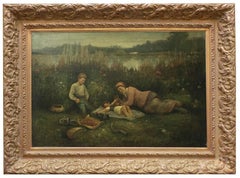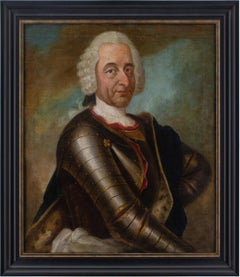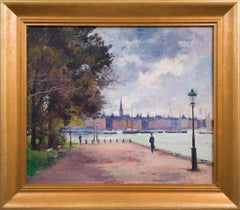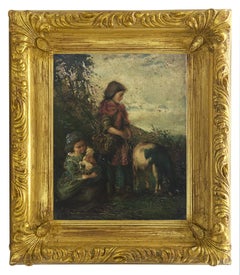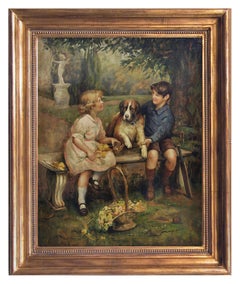Jean Philipe Moreno Paintings
to
1
1
Overall Width
to
Overall Height
to
2
1
1
1
1
2
2
1
1
1
1
2
2
2
2
2
782
713
712
698
1
2
2
Artist: Jean Philipe Moreno
SPRING PORTRAIT- French School Impressionist - Italian Oil on Canvas Painting
By Jean Philipe Moreno
Located in Napoli, IT
SPRING PORTRAIT - Oil on canvas cm.30x24 by Jean Philipe Moreno, Italy 2002.
Frame available on request from our workshop.
Moreno’s portrait depicts a young Parisian woman, her face ...
Category
2010s Old Masters Jean Philipe Moreno Paintings
Materials
Canvas, Oil
BREAKFAST ON THE LAWN - Impressionist Italian Figurative Oil on canvas painting
By Jean Philipe Moreno
Located in Napoli, IT
breakfast on the lawn Jean Philipe Moreno Italia 2002 Oil on canvas mis. cm. 60X90
Jean Philipe Moreno’s painting depicts a green and flowery landscape, a family refreshing themse...
Category
Early 2000s Impressionist Jean Philipe Moreno Paintings
Materials
Canvas, Oil
Related Items
Mid-18th-Century German School, Portrait Of An Aristocrat In Armour
Located in Cheltenham, GB
This mid-18th-century half-length German portrait depicts a middle-aged aristocrat wearing armour and a wig.
Despite his heavily-clad appearance, it’s likely that this rather noncha...
Category
1750s Old Masters Jean Philipe Moreno Paintings
Materials
Oil, Canvas
Impressionistic View over Strandvägen, Stockholm
Located in Stockholm, SE
This painting by Bernhard Oscarsson (1894-1977) is a captivating visual narrative of Stockholm's serene beauty. Oscarsson, a student of Caleb Althin's painting school and the Royal S...
Category
1930s Impressionist Jean Philipe Moreno Paintings
Materials
Canvas, Oil
French School, 17th Century, 'Portrait of the Marquise de Grugieres', oil canvas
Located in Petworth, West Sussex
French school, 17th Century
Portrait of the Marquise de Grugieres
Oil on canvas
26.1/4 x 21.5/8 in. (66.7 x 54.8 cm.)
In a gilded composite frame, later production (possible early 1...
Category
17th Century Old Masters Jean Philipe Moreno Paintings
Materials
Canvas, Oil
$6,107
H 26.25 in W 21.63 in D 1 in
Resting Boats oil on canvas painting spanish mediterranean seascape
Located in Sitges, Barcelona
Title: Resting Boats
Artist: Enric Beltrán Messa (1940–2006)
Technique: Oil on canvas
Dimensions: 15 x 18.1 in
Support: Canvas, unframed
Signature: Signed in the lower right corner
P...
Category
1970s Impressionist Jean Philipe Moreno Paintings
Materials
Canvas, Oil
$498 Sale Price
30% Off
H 14.97 in W 18.12 in
Barcelona view urbanscape oil painting Spain spanish
By Josep Marfa Guarro
Located in Sitges, Barcelona
Josep Marfa Guarro (1928-2014) Barcelona Spain Oil
Oil on canvas glued to cardboard.
Oil measures 23x28 cm. Frameless.
Josep Marfa Guarro (1928-2014)
Josep Marfa Guarro was a Cata...
Category
1990s Impressionist Jean Philipe Moreno Paintings
Materials
Canvas, Oil, Cardboard
$296 Sale Price
50% Off
H 9.06 in W 11.03 in
Antique Italian painter - 18th century figure painting
Located in Varmo, IT
Italian painter (18th century) - Chrono.
90.5 x 106 cm.
Antique oil painting on canvas, without frame (not signed).
Condition report: Lined canvas. Good state of conservation of t...
Category
Early 18th Century Old Masters Jean Philipe Moreno Paintings
Materials
Canvas, Oil
$4,743 Sale Price
20% Off
H 35.63 in W 41.74 in
Portrait of Lady Caroline Price
By George Romney
Located in Miami, FL
DESCRIPTION: Perhaps the best Romney in private hands. If Vogue Magazine existed in the late 18th century, this image of Lady Caroline Price would be ...
Category
1970s Old Masters Jean Philipe Moreno Paintings
Materials
Oil, Canvas
Impressionist Painting of a Riverscape, The Bridge at Argenteuil. Oil on Canvas.
By (after) Claude Monet
Located in Cotignac, FR
Impressionist view of a river landscape, oil on canvas board.
A charming Impressionist scene of people enjoying the delights of the riverbank. Some strolling, others enjoying a picn...
Category
Late 20th Century Impressionist Jean Philipe Moreno Paintings
Materials
Oil, Canvas, Board
$493 Sale Price
20% Off
H 14.97 in W 21.66 in
Portrait of Gentleman Blue & Cloak, Portrait of Lady, Fine Carved Gilded frames
Located in London, GB
Portrait of a Gentleman with Blue Cloak and Portrait of a Lady in Russet Dress c.1697
Thomas Murray (1663-1735)
These fascinating portraits are exquisite examples of portraiture in ...
Category
17th Century Old Masters Jean Philipe Moreno Paintings
Materials
Oil, Canvas
$27,483
H 37.8 in W 33.47 in D 2.76 in
Portrait of a Gentleman, David Erskine, 13th Laird of Dun, Wearing Armour c.1700
Located in London, GB
The gentleman in this exquisite oil on canvas portrait, presented by Titan Fine Art, is shown with the grandiloquence characteristic of the English School of painting. He is portray...
Category
17th Century Old Masters Jean Philipe Moreno Paintings
Materials
Oil, Canvas
$9,296
H 35.44 in W 30.71 in D 2.37 in
Portrait of a Lady in Green Dress & Pearl Jewellery c.1660 Painting John Wright
By John Michael Wright
Located in London, GB
In this exquisite work, painted around the time of the Great Fire of London in 1666, a beautiful young woman is wearing a green dress over a white chemise and a russet-coloured scarf...
Category
17th Century Old Masters Jean Philipe Moreno Paintings
Materials
Canvas, Oil
$13,368
H 39.38 in W 33.47 in D 3.15 in
Lakeside at Gärdsvik, Ljusterö, 1891
Located in Stockholm, SE
In the soft evening light, a lone figure rows a small boat across the calm water, while tall reeds fringe the quiet shoreline in the foreground. Rolling wooded hills embrace the lake...
Category
1890s Impressionist Jean Philipe Moreno Paintings
Materials
Canvas, Oil
Previously Available Items
COUNTRY SCENE- Neapolitan School Italian Figurative Oil on Canvas Painting
By Jean Philipe Moreno
Located in Napoli, IT
COUNTRY SCENE - Oil on canvas cm.30x24 by Jean Philipe Moreno, Italy 2002.
Frame available on request from our workshop.
The painting by Jean Philipe Moreno depicts a bucolic scene. Moreno is inspired by the paintings of the Neapolitan School of the 1800s and in particular by the Neapolitan painter Filippo Palizzi...
Category
2010s Old Masters Jean Philipe Moreno Paintings
Materials
Oil, Canvas
CHILDREN WITH DOG - English School - Italian Figurative Oil on canvas Painting
By Jean Philipe Moreno
Located in Napoli, IT
Children with dog Jean Philipe Moreno Italia 2002 Oil on canvas mis. cm. 70x55
Moreno is a traditional painter who observes and studies the great masters of the 18th century, together with his own personality he creates original works with mastery and artistic skill.
This is a reinterpretation of the London Master Arthur John Elsley...
Category
Early 2000s English School Jean Philipe Moreno Paintings
Materials
Canvas, Oil
THE WINE OF THE MASS
By Jean Philipe Moreno
Located in Napoli, IT
The wine of the Mass - Jean Philipe Moreno Italia 2002 - Oil on canvas cm. 50x40
Category
Early 2000s Old Masters Jean Philipe Moreno Paintings
Materials
Canvas, Oil
Jean Philipe Moreno paintings for sale on 1stDibs.
Find a wide variety of authentic Jean Philipe Moreno paintings available for sale on 1stDibs. You can also browse by medium to find art by Jean Philipe Moreno in canvas, fabric, oil paint and more. Much of the original work by this artist or collective was created during the 21st century and contemporary and is mostly associated with the Old Masters style. Not every interior allows for large Jean Philipe Moreno paintings, so small editions measuring 10 inches across are available. Customers who are interested in this artist might also find the work of Giulio Di Sotto, Pietro Colonna, and Matthew Cook. Jean Philipe Moreno paintings prices can differ depending upon medium, time period and other attributes. On 1stDibs, the price for these items starts at $1,592 and tops out at $3,075, while the average work can sell for $2,158.

